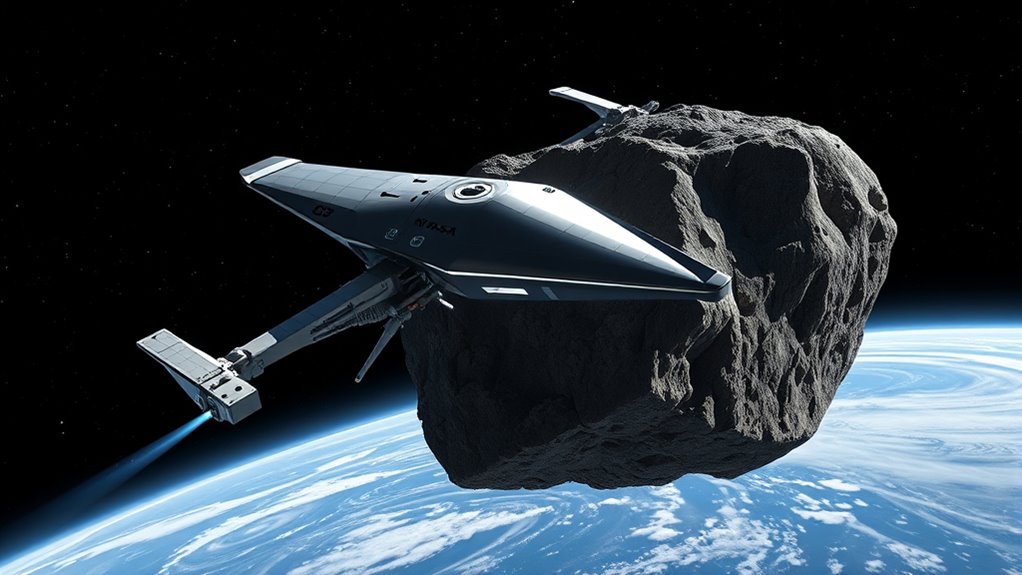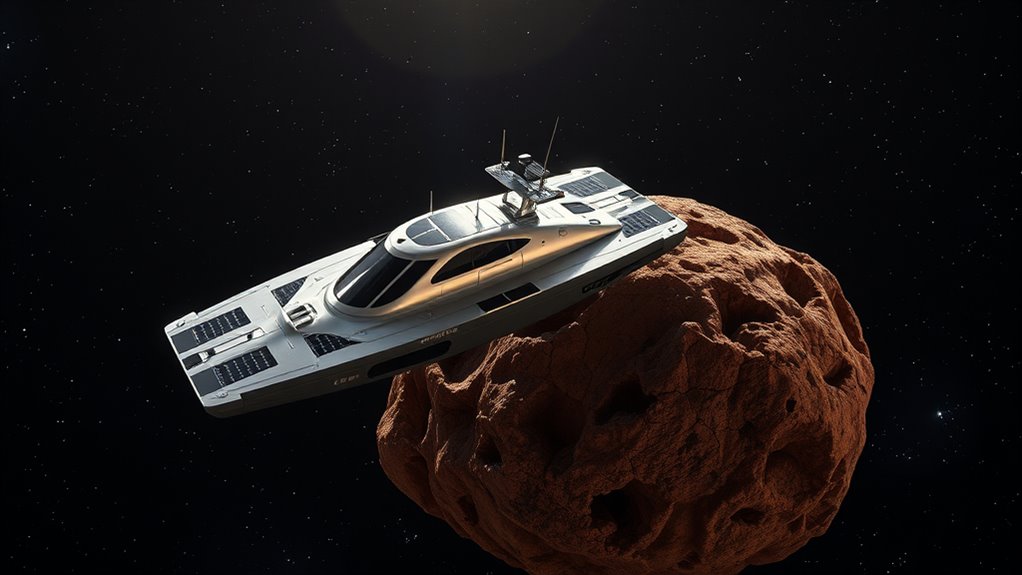NASA’s new asteroid tugboat mission could transform planetary defense by allowing you to precisely and gradually redirect dangerous asteroids away from Earth. By attaching a spacecraft to an asteroid, engineers can adjust its course over time, reducing impact risks safely. This proactive approach relies on understanding asteroid surface and composition, offering a scalable and more controlled solution. If you explore further, you’ll discover how this mission might shape the future of protecting our planet from cosmic threats.
Key Takeaways
- NASA’s asteroid tugboat aims to attach to and gradually redirect asteroids, enhancing planetary defense capabilities.
- The mission emphasizes understanding asteroid surface properties for safe and effective redirection.
- It offers a scalable, proactive approach, providing more time for impact prevention and evacuation.
- The technology demonstrates innovation in space defense, supporting future asteroid mitigation strategies.
- This initiative marks a significant advancement toward protecting Earth from cosmic threats through controlled asteroid redirection.

Have you ever wondered how scientists plan to redirect dangerous asteroids before they threaten Earth? This is the core challenge of planetary defense—finding effective ways to prevent catastrophic impacts. NASA’s latest mission, involving a new asteroid tugboat concept, could fundamentally change how we approach asteroid redirection. The idea is to attach a spacecraft to an asteroid and use its engines to slowly alter the asteroid’s trajectory over time, reducing the risk of fragmentation or unintended consequences. This method offers a more controlled, precise approach to planetary defense, giving scientists a way to manage potentially hazardous asteroids with minimal risk. Additionally, the effectiveness of this method depends heavily on understanding the color accuracy of the asteroid’s surface, which influences how the applied forces affect its movement.
This asteroid tugboat is designed to be a versatile tool in asteroid redirection. It’s not just about pushing asteroids away from Earth; it’s about understanding how to interact with these space rocks safely and effectively. The mission would involve studying the asteroid’s composition, gravity, and surface properties before applying any changes. This detailed understanding is essential because different asteroids respond differently to forces applied to them. By carefully planning the tugging process, NASA aims to demonstrate that we can steer dangerous objects away from Earth’s path without causing them to break apart unpredictably.
The concept of asteroid redirection as part of planetary defense is gaining momentum because it offers a scalable, adaptable solution. If a threatening asteroid is detected early enough, this method could slowly shift its orbit, giving us more time to prepare and evacuate if needed. It’s a proactive approach rather than reactive crisis management. With ongoing advancements in space technology, the asteroid tugboat could become a key component of future planetary defense strategies, complementing existing techniques and providing a new level of control over celestial hazards.
For you, this means a future where humanity’s ability to protect Earth from asteroid impacts becomes more reliable and sophisticated. Instead of simply hoping an asteroid will miss us, we’ll have the tools to intervene effectively, reducing the chances of a disaster. NASA’s new asteroid tugboat mission is a bold step toward this goal, showcasing how innovation in space technology can enhance planetary defense. As the mission develops, it promises to deliver essential insights into asteroid redirection, ultimately helping us better safeguard our planet from cosmic threats.
Frequently Asked Questions
How Does the Asteroid Tugboat Differ From Existing Planetary Defense Methods?
You might wonder how the asteroid tugboat differs from existing planetary defense methods. Unlike traditional techniques, it uses advanced propulsion systems to alter an asteroid’s orbit through precise control, leveraging orbital mechanics. This innovative approach allows for targeted, gentle adjustments rather than destructive interventions. By actively engaging with the asteroid’s movement, the tugboat offers a flexible, scalable solution that can be deployed earlier, reducing impact risks effectively.
What Are the Potential Risks of Deploying an Asteroid Tugboat Near Earth?
Think of deploying an asteroid tugboat near Earth like steering a ship through stormy seas. You might worry about space debris colliding with it or the mission going off course. Without proper oversight, there’s a risk the tug could accidentally redirect the asteroid toward Earth or create unpredictable debris. Ensuring strict mission oversight and thorough safety measures helps mitigate these dangers, protecting us from unintended consequences.
How Long Will the Asteroid Tugboat Mission Take From Start to Finish?
You’re wondering about the spacecraft timeline and mission duration. Typically, a mission like this could take several years from start to finish. It involves planning, development, launch, and active operation phases. The actual mission duration might span months to a few years, depending on objectives and asteroid distance. You should expect a detailed timeline that includes testing, transit, and the tug operation itself, ensuring all phases align for success.
Can This Technology Be Used to Redirect Hazardous Asteroids Away From Earth?
You can see that this technology, with advanced tugboat propulsion, could potentially redirect hazardous asteroids, depending on their composition. By understanding asteroid composition, scientists can determine the best method to apply tugboat propulsion effectively. This approach could change how we defend Earth, making it possible to nudge dangerous objects away from our planet before impact, especially with further development of propulsion systems tailored to different asteroid types.
What Are the Costs Associated With Developing and Launching the Asteroid Tugboat?
Imagine planting a seed that could grow into a shield protecting Earth. The cost analysis for developing and launching an asteroid tugboat involves significant investment, but it’s a strategic one. Funding sources range from government budgets to international collaborations. While precise figures vary, you can expect costs to be substantial, reflecting advanced technology and mission complexity. This investment aims to create a safer future by preventing catastrophic asteroid impacts.
Conclusion
As you consider NASA’s new asteroid tugboat mission, it’s inspiring to realize that this innovative approach could deflect potentially hazardous asteroids, protecting millions of lives. Did you know that over 1 million asteroids are tracked near Earth, with dozens larger than 140 meters? This mission could be a game-changer, demonstrating that with technology and determination, we can prevent disaster and secure our planet’s future. Your awareness and support make all the difference in these groundbreaking efforts.










